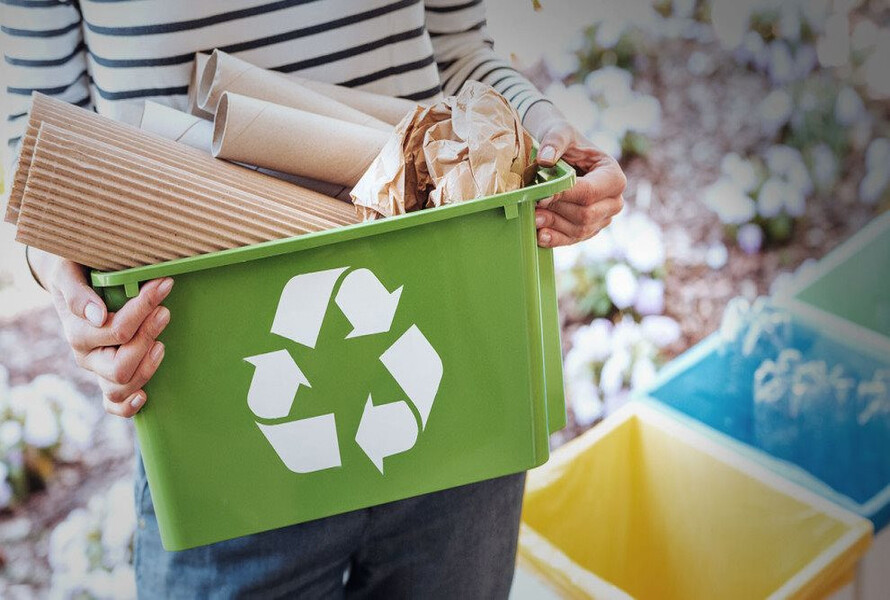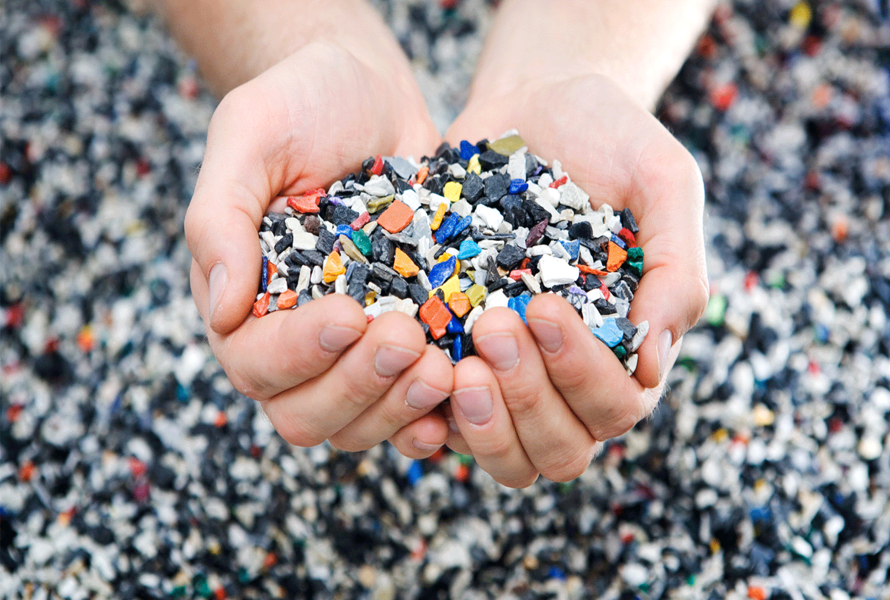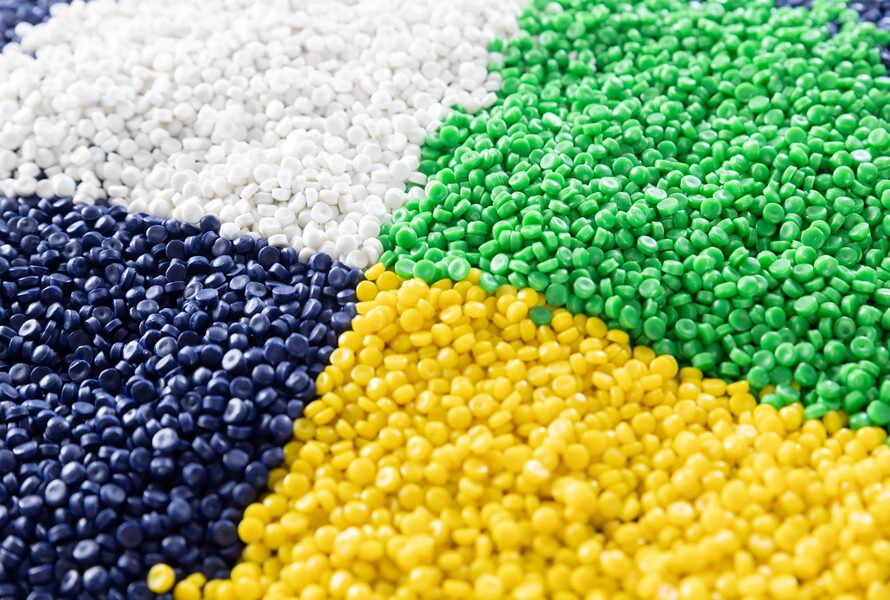Recycled plastics have become popular products in the context of countries promoting the process of treating plastic waste. Recycled plastics are divided into 2 types: post-industrial and post-consumer recycled plastics. Basically, these are 2 different types of recycled plastics and have distinct characteristics. In this article, EuroPlas will analyze in detail the definition, differences as well as answer questions about the safety of post-industrial recycled plastics. Don't miss it
1. Definition of 2 types of post-industrial and post-consumer recycled plastics
Post-consumer recycled plastics are also known as PCR, these are products recycled from people's consumer waste. Post-consumer plastic waste is collected and goes through a separate processing process to become plastic pellets.
Post-consumer recycled plastic is usually PP and HDPE plastic pellets, which are widely used for household products serving consumers' lives. In particular, the post-consumer plastic recycling process does not require the use of new fossil fuels, which meets the criteria for environmental protection as well as plastic waste treatment. However, this is also a type of recycled plastic, so the chemical structure and physical properties are also somewhat degraded.
Meanwhile, post-industrial recycled plastic (PIR) is the result of collecting and processing plastic waste after the processing process is completed. Unlike post-consumer plastic products, post-industrial waste plastic pellets are often defective products, starting scrap, conversion scrap, excess plastic pellets and other types arising during the production process at the factory.

Waste products from daily life are used to make recycled plastic after daily life.
Common types of post-industrial recycled plastic pellets are PE and PP. In particular, this is an internal recycling process and the plastic pellets still retain their physical and mechanical properties. This method not only helps manufacturers save costs and reuse input materials, but also contributes to environmental protection as well as stimulates the trend of using recycled plastic pellets.
Those are the basic definitions of the two types of post-industrial and post-consumer recycled plastics. In the next section, EuroPlas will list the differences between these two types of recycled plastics. Check it out now!
2. Differences between post-industrial and post-consumer recycled plastics
Compatibility: Post-consumer recycled plastics have undergone a long-term use and are affected by many impurities and environmental impacts. In addition, post-consumer recycled plastic pellets take a long time to collect and transport to the recycling plant. Meanwhile, post-industrial plastic waste is processed internally immediately after the production process. Therefore, the basic characteristics and properties of post-industrial plastic pellets are still maintained.
Aesthetics: Similar to the first reason, post-consumer recycled plastic pellets have been significantly affected by chemicals and external environmental factors. Therefore, the common problem of this type of plastic is that sometimes there are black spots, gray or yellow in the input material. Meanwhile, post-industrial recycled plastic only appears faded, but not too significantly. Basically, this factor can be improved by combining with plastic additives to increase the necessary properties of plastic pellets.

Post-industrial and post-consumer recycled plastics differ in physical properties and practical applications.
Uniform quality: Post-industrial recycled plastic will have more uniform quality and stability than post-consumer plastics. The main reason is because the low percentage of post-industrial recycled plastic is affected or contains impurities from the outside environment, and they will be easily eliminated. In addition, post-industrial raw materials or waste products all undergo a strict inspection process according to ISO 14021:2016. Although post-consumer recycled plastics also need to ensure this standard, we do not rule out the possibility that impurities still exist deep in their physical structure and chemical bonds.
Cost: If we consider the quality price perspective, post-industrial recycled plastic will be more expensive than post-consumer recycled plastics. This is also confirmed by the 3 main differences above between the two types of plastic. In general, using recycled plastic can help businesses save 30 - 40% of mass production costs. In addition, the 2020 - 2030 market analysis of IDTechEx reported by the magazine "Polymer Technology and Recycling" indicates that: this market is predicted to become a future trend and is estimated to reach 175 billion USD by 2030.
Practical applications: Post-industrial and post-consumer recycled plastics also show differences in practical applications. Most post-industrial recycled plastics are used to manufacture equipment and products serving key economic sectors such as: Healthcare, heavy industry, electronics, automobiles, agriculture. Meanwhile, post-consumer plastic waste is recycled and serves light sectors, close to life such as: Fashion, household appliances, public toilet equipment, food packaging... Although different in practical applications, both have been and are bringing the most practical values to the environment, community & society.

Recycled plastics are combined with additives to enhance properties and quality.
Heat resistance: Common post-industrial recycled plastic is PP plastic pellets. PE plastic lines such as HDPE, LDPE are more suitable for post-consumer recycled plastic pellets because PE's heat resistance is up to about 100 degrees Celsius and its melting point is between 165 - 200 degrees Celsius. On the contrary, the maximum temperature of PE plastic is about 230 degrees Celsius, but only for a very short time. This difference can be changed thanks to benign plastic additives during processing.
EuroPlas has analyzed 6 differences between post-industrial and post-consumer recycled plastics. From an overall perspective, recycled plastic pellets have more advantages than disadvantages. They and bioplastics are the trend of the world's plastic industry in the future. In particular, countries around the world are trying to find practical solutions in handling plastic waste, so recycled plastic will also be an effective choice.
So with 6 differences and other advantages, is post-industrial recycled plastic toxic or not? The answer will be answered in detail below.
3. Are post-industrial recycled plastics more toxic?
As EuroPlas mentioned above, the origin of recycled plastic pellets is largely from post-industrial or post-consumer waste. Therefore, we cannot rule out the possibility of residual impurities or negative changes in their chemical structure, which can produce toxins that affect the health of consumers. However, manufacturers have prepared extremely detailed selection and processing procedures from the stage of importing recycled materials to thoroughly minimize the amount of impurities. That is why ISO standards need to be established.
In addition, professors and scientists from the University of Gothenburg, IPEN, Aarhus University, and Exeter University stated in the journal Science 1 about recycled plastics that: "Although recycled plastics are considered a practical solution in the treatment of plastic waste, potential toxins before and during the processing can affect plastic recycling workers". Therefore, the important issue to be solved here is the professional processing process from the time of collecting plastic waste to the final product. On Tinh Te magazine, there is an excerpt of the comment of Associate Professor, Dr. Nguyen Duy Thinh, former lecturer of the Institute of Biotechnology and Food (Hanoi University of Science and Technology) that: "Not all types of plastic can be recycled, they depend on cost, size and characteristics. For example, if industrial waste is too large, manufacturers will consider turning it into PIR plastic."
-l%C3%A0-th%C3%A0nh-qu%E1%BA%A3-c%E1%BB%A7a-vi%E1%BB%87c-t%E1%BA%ADp-h%E1%BB%A3p-v%C3%A0-x%E1%BB%AD-l%C3%BD-c%C3%A1c-ph%E1%BA%BF-ph%E1%BA%A9m-nh%E1%BB%B1a-sau-khi-qu%C3%A1-tr%C3%ACnh-gia-c%C3%B4ng-k%E1%BA%BFt-th%C3%BAc.jpg)
Post-industrial recycled plastic (PIR) is the result of collecting and processing plastic waste after the processing process is completed.
Currently, there are 3 types of plastic that are safe after recycling: PET, HDPE and PP. Meanwhile, PC, PS, LDPE and PVC are 4 types of plastic that are recommended not to be recycled for household products because their toxins and chemical composition will affect the health of consumers. Therefore, post-industrial recycled plastic will not be too toxic, this depends on the supplier and the previous processing process. That is why post-industrial recycled plastic products are often single-use products such as: Packaging, paper boxes, ... or basic plastic products such as: Chairs, tables, plastic basins. The government needs to establish measures and policies to create common standards for the processing of post-industrial and post-consumer recycled plastic products. In addition, we must have regulations on the use of recycled plastic pellets in each specific product and field.
4. About EuroPlas
EuroPlas is one of the pioneers in recycling and "greening" the domestic and foreign plastics market. We are proud to be one of the largest Filler Masterbatch manufacturers in the world and provide optimal bioplastic products to help businesses improve their competitive position in the market.
Over the years, EuroPlas has contributed and created sustainable values for customers and plastic suppliers worldwide. Plastic products in general, bioplastics and recycled plastics in particular at EuroPlas are manufactured and inspected by a team of leading experts in the region.
EuroPlas is confident that it can supply up to 0.8 million tons to meet the large demand of customers nationwide with a system of 7 large-scale factories in 6 provinces and cities: Ha Nam - Yen Bai - Hai Phong - Nghe An - Long An and Ho Chi Minh City.
5. Conclusion
The article has detailed the definition, differences and advantages and disadvantages of post-industrial and post-consumer recycled plastics. Next, EuroPlas has also answered the question of whether post-industrial recycled plastics are more toxic and suggested some solutions for recycling plastic waste. Please continue to follow EuroPlas to update the latest news about plastic products!